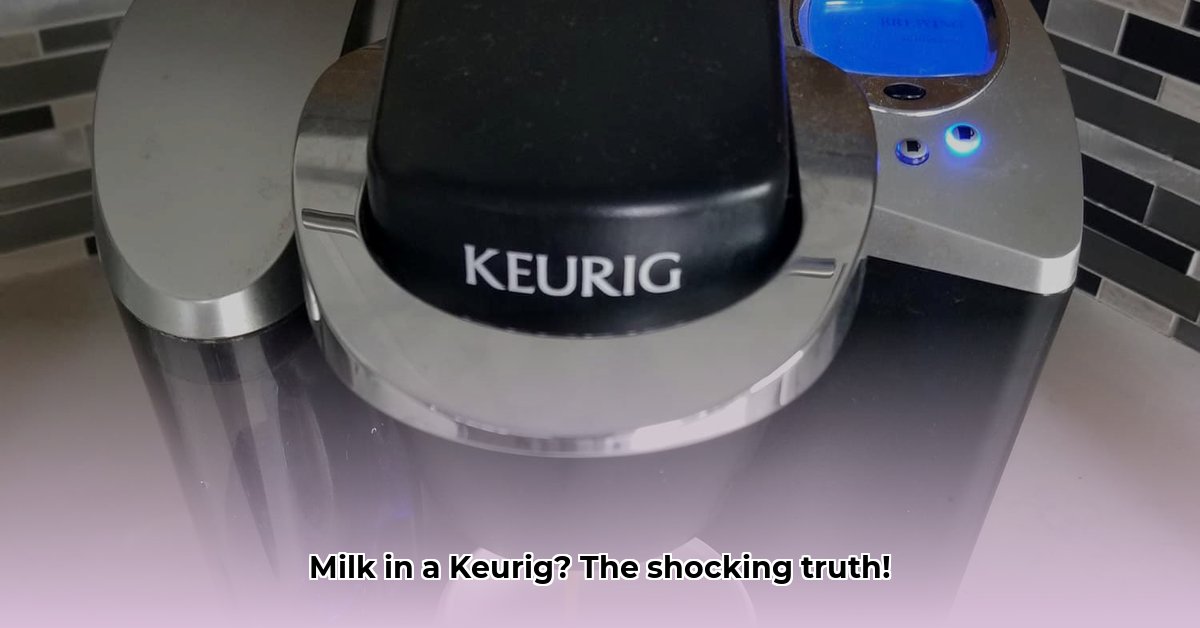No, you absolutely cannot put milk directly into a Keurig coffee maker. Think of it like trying to run a car on maple syrup – it’s just not going to work, and you’ll likely end up with a sticky, smelly mess. While the allure of instant milky coffee is strong, your Keurig is designed for water only. This “no” is for the good of your machine (and your taste buds!). But don’t worry, there are plenty of delicious, Keurig-friendly ways to get your milky coffee fix. Keep reading for the why, the how, and what to do if disaster strikes (because, hey, it happens).
Why Milk and Keurigs Are a Recipe for Disaster
So, why is milk the kryptonite of your Keurig? Several reasons:
- Viscosity: Milk’s thickness (its viscosity) is the primary culprit. It’s like trying to pour pancake batter through a straw – it’s just too thick to flow smoothly through the Keurig’s delicate inner workings. This can lead to clogs, slow brewing, or even a complete halt to your coffee-making operation.
- Bacterial Growth: Milk left in a warm, dark environment (like the inside of your Keurig) is a breeding ground for bacteria. This can result in unpleasant odors, off-flavors, and even potential health risks. Nobody wants a science experiment brewing in their coffee maker.
- Warranty Void: Most Keurig warranties explicitly state that using anything other than water can void the warranty. So, that quick fix could end up costing you big time in repairs or a replacement machine.
- Damage to Components: Milk can also damage the heating element and other internal components of your Keurig. The milk solids can burn onto these surfaces, creating a difficult-to-clean mess and potentially affecting the machine’s performance.
Delicious Alternatives for Milky Coffee with a Keurig
Now for the good news: you can enjoy delicious, milky coffee with your Keurig – just not by putting milk directly into it. Here are some tasty and safe alternatives:
-
Milk Frothers: These handy gadgets transform ordinary milk (dairy or non-dairy) into a light, airy foam, perfect for lattes, cappuccinos, and more. Simply brew your coffee as usual, froth your milk, and combine for a cafe-quality experience at home. [Link to a good milk frother article/review]
- Handheld Frothers: These are budget-friendly and perfect for occasional use. [Link to a handheld frother product]
- Electric Frothers: These offer more features, like temperature control and different frothing settings. [Link to an electric frother product]
-
Flavored K-Cups/Pods: Many brands offer K-cups with powdered creamer or milk already included for a quick and convenient option. While the flavor options might be somewhat limited, they’re ideal for a fast and easy milky coffee fix. [Link to flavored K-cups]
-
Keurig K-Cafe (and Similar Models): These Keurig models feature a built-in milk frother, streamlining the process of making milk-based coffee drinks. They’re a great investment for latte and cappuccino lovers. [Link to a Keurig K-Cafe review]
-
Milk Pods (Dry Milk/Creamer Pods): These single-serve pods contain powdered milk or creamer and are designed to be brewed just like a regular K-cup. While the result may not be as rich as fresh milk, it’s a practical alternative for convenience. [Link to milk pods]
-
Creamer (Liquid or Powdered): A classic choice! Add your preferred creamer after brewing. Experiment with different flavors and find your perfect match! [Link to article on different types of creamers]
The Milk-in-Keurig Emergency: A Troubleshooting Guide
Okay, let’s say the unthinkable happened. You accidentally poured milk into your Keurig’s water reservoir. Don’t panic! Quick action can minimize the damage. Here’s what to do:
- Unplug: Immediately unplug your Keurig to prevent further damage and ensure safety.
- Empty and Rinse: Empty the water reservoir and rinse it thoroughly with warm, soapy water. Rinse well to remove any remaining milk residue.
- Flush the System: Run several brewing cycles with fresh water without a K-cup. This will help flush out any lingering milk.
- Vinegar Solution: Brew a cycle using a 50/50 mixture of water and white vinegar. Vinegar is a natural cleaning agent and can help dissolve milk residue. Note: While some experts suggest vinegar, ongoing research explores the long-term effects of different cleaning solutions. Check your Keurig manual for recommended cleaning procedures.
- Rinse Again: Run several more brewing cycles with fresh water to eliminate any vinegar taste.
- Inspect and Clean: Carefully inspect the needle, K-cup holder, and other accessible parts for any remaining milk residue. Use a small brush or toothpick to gently remove any clogs.
- Call for Backup (If Necessary): If your Keurig still isn’t functioning correctly, contact Keurig customer support or a qualified appliance repair technician. It’s always best to consult a professional if you’re unsure about anything.
Frequently Asked Questions (FAQ)
- Can I use plant-based milk with a Keurig? Absolutely! Just froth it separately or add it to your brewed coffee. Plant-based milk is a great alternative for those with dietary restrictions or preferences.
- What about powdered creamer? Yes, powdered creamer is perfectly safe to use with your Keurig. Add it directly to your brewed coffee.
- How often should I descale my Keurig? It’s generally recommended to descale your Keurig every 3-6 months, depending on your water hardness. This removes mineral buildup and keeps your coffee tasting its best. [Link to a descaling guide]
Conclusion: Milky Coffee Bliss, the Keurig-Safe Way
So, while you can’t put milk directly into your Keurig, you can still enjoy a wide variety of delicious milky coffee creations. By using the alternatives outlined above and following the troubleshooting guide in case of accidents, you can keep your Keurig happy, healthy, and brewing delicious coffee for years to come. Experiment, explore, and find your perfect cup!
- Wellness Fair Ideas for Work to Boost Employee Wellbeing - December 15, 2025
- Affordable Employee Wellness Fair Ideas for Any Budget - December 14, 2025
- Employee Wellness Programs Strategically Benefit Employee Health And Retention - December 13, 2025
















